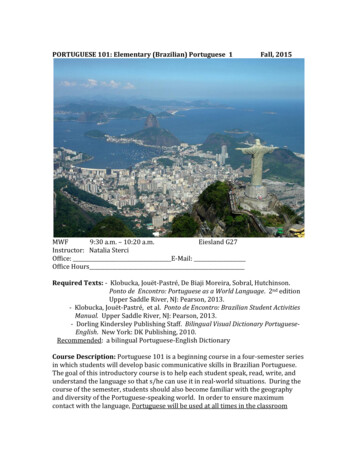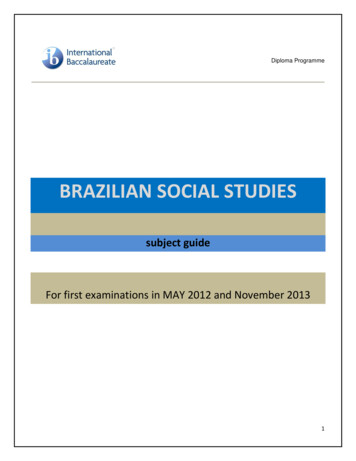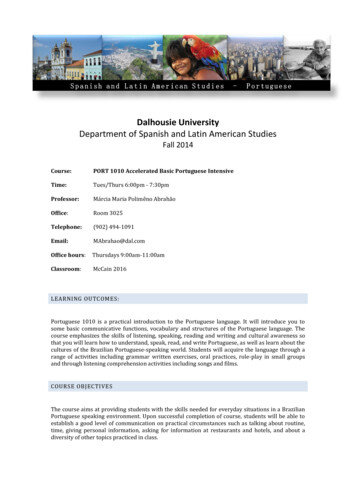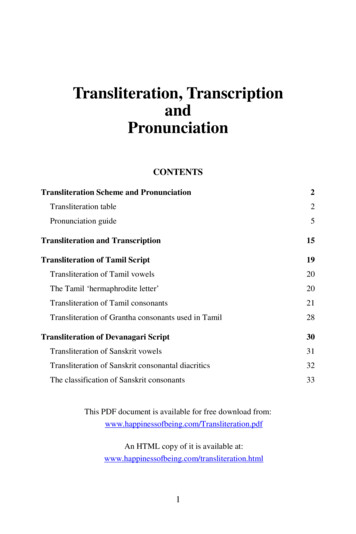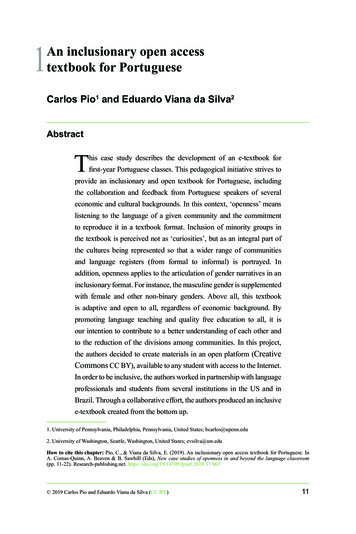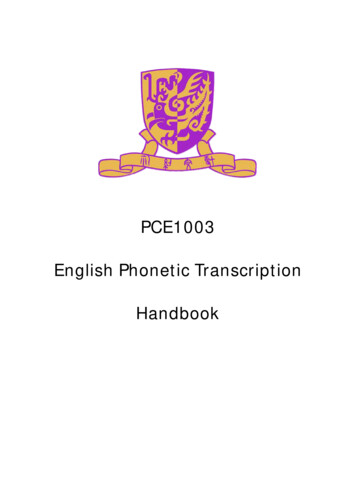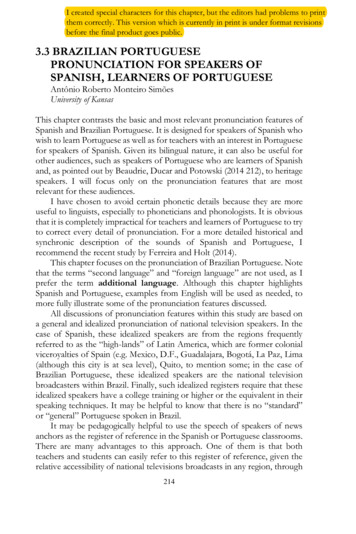
Transcription
I created special characters for this chapter, but the editors had problems to printthem correctly. This version which is currently in print is under format revisionsbefore the final product goes public.3.3 BRAZILIAN PORTUGUESEPRONUNCIATION FOR SPEAKERS OFSPANISH, LEARNERS OF PORTUGUESEAntônio Roberto Monteiro SimõesUniversity of KansasThis chapter contrasts the basic and most relevant pronunciation features ofSpanish and Brazilian Portuguese. It is designed for speakers of Spanish whowish to learn Portuguese as well as for teachers with an interest in Portuguesefor speakers of Spanish. Given its bilingual nature, it can also be useful forother audiences, such as speakers of Portuguese who are learners of Spanishand, as pointed out by Beaudrie, Ducar and Potowski (2014 212), to heritagespeakers. I will focus only on the pronunciation features that are mostrelevant for these audiences.I have chosen to avoid certain phonetic details because they are moreuseful to linguists, especially to phoneticians and phonologists. It is obviousthat it is completely impractical for teachers and learners of Portuguese to tryto correct every detail of pronunciation. For a more detailed historical andsynchronic description of the sounds of Spanish and Portuguese, Irecommend the recent study by Ferreira and Holt (2014).This chapter focuses on the pronunciation of Brazilian Portuguese. Notethat the terms “second language” and “foreign language” are not used, as Iprefer the term additional language. Although this chapter highlightsSpanish and Portuguese, examples from English will be used as needed, tomore fully illustrate some of the pronunciation features discussed.All discussions of pronunciation features within this study are based ona general and idealized pronunciation of national television speakers. In thecase of Spanish, these idealized speakers are from the regions frequentlyreferred to as the “high-lands” of Latin America, which are former colonialviceroyalties of Spain (e.g. Mexico, D.F., Guadalajara, Bogotá, La Paz, Lima(although this city is at sea level), Quito, to mention some; in the case ofBrazilian Portuguese, these idealized speakers are the national televisionbroadcasters within Brazil. Finally, such idealized registers require that theseidealized speakers have a college training or higher or the equivalent in theirspeaking techniques. It may be helpful to know that there is no “standard”or “general” Portuguese spoken in Brazil.It may be pedagogically helpful to use the speech of speakers of newsanchors as the register of reference in the Spanish or Portuguese classrooms.There are many advantages to this approach. One of them is that bothteachers and students can easily refer to this register of reference, given therelative accessibility of national televisions broadcasts in any region, through214
the Internet, a common tool in today’s classrooms. Furthermore, the registerof a national news anchor tends to be closer to the formality of the writtenlanguage while still sounding natural. In other words, we may sometimes findnative speakers who are excessively concerned with maintaining a “purespeaking style,” and wind up speaking in a pedantic or artificial manner.Usually, that is not the case with national news anchorsTherefore, the goal of this contrastive description of Spanish andBrazilian Portuguese is to provide key practical information about the soundsystems of Spanish and Brazilian Portuguese that will help speakers ofSpanish to learn the sound system of Portuguese. The contrastive descriptionof how pronunciation patterns operate in these two languages is intended tobe a user-friendly reference.This chapter is organized into three parts. Part I explores the basicpronunciation differences of vowel and consonant segments, as well as someof the most common and productive phonological processes in BrazilianPortuguese.It must be noted that the first section is intended for readers with littleor no background in Linguistics. Part II provides a practical application forthe discussion in Part I. It proposes ideas for creating strategies to learn andteach Brazilian Portuguese to speakers of Spanish. Part III expands on Part1 by discussing additional contrasts between Spanish and Portuguese,especially in terms of language prosody, i.e. suprasegmentals; therefore, itrequires some background in linguistics.How the Sounds of Portuguese and Spanish Work: A Basic ContrastTable 1 explains the symbols used in this study. Please refer to it as needed.It also lists common conventions for transcribing speech.Table 1. Phonetic symbols for Brazilian terPhonetic SymbolAlphabetLetterPhonetic Symbola[a] atoir[ɾ] raro, três, verã, anam[ã] lã, antes [ã\s\upper 1 ( ]falam[b] botoimin[i] cisco[i] seis[ĩ] or [ĩ ĩ] sim[ĩ] sintorj[ӡ] jogo[s] cito, céu[k] cama,com, culpa[s] dança,laço, açúcark[k] kartrrl[l] brasileiro[u] Brasils/R/[x] raro, ver[h] raro, ver[χ] raro, ver[я] raro, ver[Ø] mute ver/R/[x], [h], [я], [χ] [r]carro/S/[s] três, [z] desde[ʃ] três, [ӡ] desdebcç215
ch[ʃ] Chicolhd[d] desde,dar, do, duas[ʤ] digo,bode, desde[e] seja[ε] sete[i] sete[i] passear[ε] Zé[e] zê[ \s\upper1 ( ĩ] bem[ \s\upper1 ( ] bento[f] foto[g] gol, gala,gula[ӡ] giz, gê[g] pague,seguintemeéêemenfg o,a,ug i,egu e,igu e,i[gu] aguentar,arguirh[Ø] mute:hotel[liy] or [λ]filho[m] mais[ ] campo,boms[z] asass[s] assan[n] cana[ ] canto, zent[t] teve, tal, tom,tuna[ʧ] time, partenh[i y] or [ŋ]tenho[o] amor[ɔ] modo[u] modo[u] enjoou[u] úvula,[u] estou[u ] or [ 1 ( \s\upper 1 ( \s\upper] bum![u ] nuncaovw[v] voto[v] Oswald[u] watt[õ] or [ã\s\upper 1 ( ]bom[õ] põe, tonto[p] pato[k] parque,aquilox[ku] eloquente,tranquiloz[s] trouxe[z] exato[ks] nexo[š] Texaco[i] Lisy[i] Bley[ӡ] jarda[z] fazeróô[ɔ] dó[o] avôomõ, onpqquumun yThese symbols reflect an approximation of the pronunciation of nationalnews anchors. The symbol [ ] indicates nasality. The variant pronunciationsof r, rr , [χ] and [я] are less common. The capital letters /S/ and /R/represent a range of pronunciations, which depends on factors such aspersonal preferences, language varieties, and others. This table shows onlyisolated changes. It does not take into account changes made by thesurrounding sounds or contexts. For instance, the examples for s in thewords tres and desde do not show an [i] that may or not surface in thepresence of /s/ as in [tɾes, tɾeis, dezde, deizde, tɾeiʃ, deӡde, deiӡde].Segments: Vowels.This study assumes that Brazilian Portuguese hasseven oral vowels and five nasal vowels. Regardless of how we approach thedescription of the Portuguese vowel system, there are more vowels inPortuguese than in Spanish. Furthermore, among the college-educatedSpanish population, the Spanish vowels are relatively more stable than inPortuguese, meaning that the vowels in Spanish do not change their features216
(or qualities) as much as Portuguese or English do.Interestingly, native speakers of Portuguese understand a good deal ofspoken Spanish, whereas native speakers of Spanish frequently have moredifficulty understanding basic spoken Portuguese. It is often attributed to thelate Brazilian linguist Mattoso Câmara, Jr. the explanation that the mainreason for this was due to the difference in the number of vowels within thetwo languages. However, there are other reasons, vowel instability inPortuguese being one of them. Jensen (1989) empirically observed anddescribed this phenomenon of mutual intelligibility in his study.Changes in vowel quality permeate Portuguese and this vowel instabilityhas characterized the language throughout its evolution. Vowels inPortuguese change depending on their context. The vowels e and o ,for example, in the word escrito are commonly pronounced [i] and [u],[iS. kri.tu], because of contexts or factors such as their position in the word,the degree of stress, the register, to mention some. On the other hand, at theend of the word escritor the vowel o does not change, it is pronounced[o], [iS.kri. toR], because of another factor, i.e. the [o] is in a strong position,a stressed position. Spanish, relative to Portuguese or English, tends to mirror,although not perfectly, what is written, in the register of spoken Spanish justreferred to in this study.In addition to coming to grips with vowel instability in Portuguese,Spanish speakers will have to learn seven more vowels to become proficientin Brazilian Portuguese. Although the Portuguese alphabet contains fiveletters to represent its vowels, a, e, i, o, u , these letter symbols are notsufficient to represent the actual number of 12 vowel phonemes.Among the vowels of Brazilian Portuguese, the narrow-mid oral vowelsin Brazilian Portuguese, Table 2, are probably the greatest challenge tospeakers of Spanish who are learners of Brazilian Portuguese and also tospeakers of English learning Portuguese.A common way of describing the Portuguese vowel phonemes ispresented in Table 2. The ones that occur only in strong position are the onesin the boxes with a darker background. Note that the central vowel, referredto as schwa (/ə/), has an “only in EP” under it. This is to indicate that it is avowel phoneme that normally appears only in European Portuguese. Maybethere is a recent trend of production of schwas in Brazilian Portuguese, butif it is the case, the trend may be limited to some regions and in limitedcontexts. In American English, all unstressed vowels in spontaneousdiscourse tend to centralize, i.e. to reduce to a schwa. The underlined vowelsof the English words about and southern are examples of schwas inunstressed and stressed syllables28 respectively. Spanish, perhaps with theThe Merriam-Webster dictionary defines schwa as “an unstressed mid-central vowel.”This is also a common definition among some linguists. But it is common to have schwas in28217
exception of some varieties of Spanish spoken in the US, normally does nothave schwas in the register we use as reference in this study.Table 2. The vowel system of Portuguese, based on Simões (2008)Front/ i / mito/ i /minto, pintura/ e / cedo/ ẽ /sendo,acendendo/ є / Zeca/ ɛ /sendoRetractedRoundCentralBack or Velar/ ũ / mundo,mundano/ u / mudo/ õ / bonde,bondade/ o / pôde/ɔ/pode/ə/only in EP/ ɐ /manta/a/mata“Close” orHigh/WideHigh/Wide-midLow/Narrowmid“Open” orLow/NarrowRetractedRoundRoundBoxes with a darker background show vowels that appear only in strongposition, namely stressed syllables. The tilde ( ) over a vowel means that thevowel is nasal. Note that this table indicates that the nasal vowel in sendo iseither front, high/wide-mid (semi-fechada), or front low/narrow-mid (semiaberta). Traditionally, this vowel has been described as high/wide-mid or semifechada.Spanish speakers, learners of Portuguese will need to learn thePortuguese vowel phonemes not present in Spanish, in addition to learningor perceiving the changes in vowel quality, because these phonemes and theirchanges in quality are very productive in Portuguese. English and French, forexample, have narrow-mid or low mid-vowels that do not correspond exactlyto the Portuguese ones. Hence the difficulty that English and French speakerhave as well, and Spanish speakers even more, to produce oral narrow-midvowels in Portuguese, traditionally called “open vowels.”The nasal vowel phonemes may pose some difficulties, but not as muchas the open vowels. Finally, some Spanish speakers who speak English asnative or near-native language often find the features or terms lax and tensemore helpful than the terms used here, narrow-mid or open. The narrowmid or open oral vowels in English are usually described as lax vowels.Therefore, vowel instability is most likely one of the main factors if notthe main factor that makes the intelligibility of Portuguese harder for nativespeakers of Spanish than the intelligibility of Spanish for native speakers ofPortuguese (Simões, 2008).stressed position (e.g. Southern). Hence, I have adopted the definition of schwa as “areduced and mid-central vowel.”218
Given the information in the preceding paragraphs, unstressed vowels inPortuguese change in quality. These changes may result in other phonologicalprocesses or phonological rules. In Brazilian Portuguese, a person whochanges /e/ to [i] will also change the pronunciation of /t/ and /d/, whenthese consonants appear before [i], as inSourcefutebol (soccer):/fu.te. bͻl/cor-de-rosa (pink (color)):/ koR.de. Rͻ.za/Intermediate StepFinal Output [fu.ti. bͻu][fu.tʃi. bͻu] [ kox.di. xͻ.zɐ][ kox. dʓi. xͻ.zɐ]Note that the unstressed vowel [ɐ] is used here, instead of the schwa seenin other transcriptions. The symbol [ɐ] represents an unstressed vowelallophone, but not a schwa. With respect to the [e] and [i] alternations, if theperson’s pronunciation does not change the /e/ to [i], then /t/ and /d/ willremain as they are, alveolar [t] and [d] and, in this person’s pronunciation,that is to say the output will be [fu.te. bͻu] and [ kox.de. xͻ.zɐ]. Note that in cor-de-rosa I used [x] for the r because it is a very commonpronunciation. Obviously, there are other possibilities, as shown in Table 2.With respect to diphthongs, speakers of Spanish, as well as speakers ofEnglish, should not have difficulties saying diphthongs in Portuguese. Theonly obstacle may be to remember their forms, especially in the forms ofthe verbs in the Preterit verbal aspect of the Indicative mode, e.g. falou (Span. habló ), amanheceu (Span. amaneció ), saiu ( Span. salió ). Comparison of Oral Vowels in Spanish and Brazilian PortugueseComparison of Oral Vowels in Spanish and Brazilian Portuguese,Using English Vowels When Spanish Lacks the Equivalent(Male speaker, capixaba-colatinense from Espírito Santo)SpanishBrazilianEnglish closer equivalentsPortuguese/i/ Brasilia/i/ Brasília/e/ (el) peso/e/ (o) peso/e:/bait; (also /ι/ as in bit)No equivalent/ε/ (eu) peso/ε/ pet; (also /æ/ as in Pat)/a/ Machado/a/ MachadoNo equivalent/ͻ/ posso/ͻ/ bought, awe/o/ pozo/o/ poço/o:/ boat/u/ Hugo/u/ HugoSegments: The Nasal Vowels of Brazilian PortugueseIn general, neither Spanish nor English have nasal vowels that changethe meaning of a word when replaced by a corresponding oral vowel.English speakers may have a slight advantage here because English does219
have the interjection “uh-huh” (/ã- hã/), which can be regarded forteaching purposes as a very close equivalent of Brazilian Portuguese /ã/, asin cantando. A special challenge for speakers of Spanish and English as wellwill be the nasal sounds at the end of a word. In addition to hearing howthese sounds are produced in Brazilian Portuguese, they also have to takeinto account their misleading spelling. For instance, Brazilian Portuguesewords like um, bem, sim, Cancun, porém, festim, garçom, som, nenhum,assim, falam, vem, porém, aparecem and many others that end in –n or –m, are pronounced with a nasal vowel or diphthong. The written –n and –mare not pronounced. The visual image of words spelled with a final –n or –m tends to mislead non-native speakers. Despite the spelling, –n and –m aremute, but where they appear, they generally make the preceding vowel lettera spoken nasal vowel or a nasal diphthong.Therefore, the nasal consonant letters, –n and –m, are written but notnormally pronounced. The student must hear the different nasal feature ofthese vowels in word final position and produce them accordingly. (Simões2008; 2013) The table below provides a summary of the nasal vowels.Spanish anPortuguese /\s\upper2 ( / assim /\s\upper1 ( / centro/ã/ rã/õ/ tom/u / atumNote that Spanish speakers should not havenasal vowels inside a word.English closer equivalentsNo equivalentNo equivalentuh-uhNo equivalentNo equivalentdifficulties using PortugueseSegments: Consonants. In Brazilian Portuguese, in the speech of nationaltelevision speakers, the consonants tend to be well articulated. For example,a stop consonant, voiceless or voiced, is realized as such. Thus, speakers ofEnglish should have no problems pronouncing most of them, whereasspeakers of Spanish will need to make an extra articulatory effort to avoid theapproximant trait of most Spanish consonants in actual discourse.Table 3. The consonants of Portuguese, compared to English and Spanish. Adapted fromSimões (2008).Comparison of Spanish and Brazilian Portuguese Consonants,Using Some of the English Consonants as Interface220
Closest soundcorrespondences,in Spanish/p/ pura/b/ [b] in sentence initialposition, as in ¡Vaya!, inMéxico, D.F. or Madrid, butnot soft [β] as in abuelo,everywhere./t/ taco/d/ [d] in sentence initialposition, as in ¡Dale! inMéxico, D.F. or Madrid, butnot [ð] as in nada,everywhere./k/ casa/g/ [g] in sentence initialposition, as in ¡Gooolll! inMéxico, D.F. or Madrid, butnot [γ] as in pago,everywhere./m/ mapa/n/ nada/ɲ/ or ñ mañana (inSpanish it is a palatalphoneme)/f/ féNo equivalent/s/ séNo equivalentNo equivalent phonemeandyNo equivalentphoneme(Brazilian) PortugueseEnglish/p/ pura/p/ spot/b/ botar (in Span. poner)/b/ boy/t/ taco/t/ stop/d/ Ada/d/ day/k/ casa/k/ sky/g/ a gata/g/ goal/m/ mapa/n/ nada/ŋ/ [iỹ] manhãNote: The use of velarsymbol /ŋ/ is not ideal,but it helps avoidingSpanish /ɲ/. Spanish “ñ”and Portuguese “nh” arevery different. Spanish “ñ”is more of an anteriorarticulation; Portuguese“nh” is posterior, a tonguefeature that pushes thepalatal contact furtherback in Portuguese, closerto the velar area. Thesymbol [ỹ] or [iỹ] may bethe best solution torepresent “nh” in BP./f/ fé/v/ votar/s/ sei, caça, cassa/z/ fazer, casa/ʃ//š/ acho/ʒ//ž/ ajo, garage/m/ me/n/ no221No equivalent; butusing ni as in onionhelps/f/ fault/v/ vault/s/ sea/z/ zoo/ʃ/ mission, fish/ʒ/ vision
/r/ or rr querría, carro;softer thanBP [rr][x] rota, carro, genro,desrespeito; Othervariants: [h], [я], [χ], [r][r] or rr rota, carro,genro, desrespeito; harderthan in Spanish;/ɾ/ quería, práctica, caro/ɾ/ queria, práctica, caro/l/ lata/ʎ/ or ll caballero, stillused (although less thanbefore) in the center andnorth of Spain/l/ lata/x/ jota/ʎ// cavalheiro or[ka.va. ʎei.ɾu]The h-sound, as in“hope” is fineNo equivalent[ɾ] batter, better inAmerican English/l/ lowno equivalentphoneme, butEnglish sequence lliin million is similar.Taking into account the preceding comments and the soundcomparisons in Table 3, there are two sets of consonants containingsignificant phonetic differences that need special attention and pronunciationdrills. The first of these sets is b, d, g , and the second one is formed withthe two sounds spelled ll and ñ in Spanish and lh and nh inPortuguese.Comparison of Spanish and Brazilian Portuguese b d g , and theInsertion of [i] and [e] in Brazilian Portuguese. The most obviousdifferences between this set of sounds in Spanish and Brazilian Portuguese isthat in Spanish these sounds are produced as soft or approximant consonantsmost of the time, especially when they appear between vowels, in actualdiscourse. Relative to Spanish, Brazilian Portuguese, like English, producesthese sounds as hard, i.e. stop consonants. In other words, in the productionof b d g the articulators, i.e. lips, tongue, jaw, soft and hard palates, willeither approximate each other without full contact (approximants or softconsonants) or they will touch each other (hard or stop consonants).Generally in Spanish, the articulators do not come into contact. Speakers ofSpanish must make sure that these articulators come into contact whenspeaking Brazilian Portuguese. There are some varieties of Spanish that mayhave actual stop consonants, especially in the register of some news anchors.In general, however, native speakers of Spanish makes these b d g soundssoft, i.e. approximants. As an illustration, the pronunciation of the word abogado can be represented in a series of gradual phonetic variations,which we summarize here with three common representations, abogado , abogado , aoao , to reflect the different degrees of variation of b d g .In this summary of gradual variations, the first representation, abogado ,is what may be expected in the speech of a news anchor. The smaller sizes ofthe fonts are intended to show the different degrees of variations orreduction, from very slight reduction to complete reduction (deletion) ofthese sounds, depending on the situation or contexts such as geographical222
area, social class, register, to mention some. In another illustration, in thesentence the highlighted consonants have varying degrees of reduction, e.g. abuelita, auelita; cansada, cansaa, cansá; aguanta, auanta .Mi abuelita está cansada, ya no aguanta más,There is also the case of the consonant d , which is dental in Spanishand alveolar or alveopalatal for the majority of Brazilian population. InPortugal, and in some areas of Brazil, there are dental d s. However, thereare general descriptions of Brazilian Portuguese (Silva 2005) that describe d and t as dentals, as if this feature were the most common realizationsof d and t , in Brazilian Portuguese. I think this is misinterpretation canbe explained. In Brazilian Portuguese, the tip of the tongue is not the pointof contact with the alveolar region. The alveolar region is the area of the rootof the front upper teeth. In the pronunciation of d and t , the front orblade of the tongue, not the tip of the tongue, touches the alveolar area, inBrazilian Portuguese. If t and d were dental consonants in BrazilianPortuguese in general, they would simply sound like Spanish t and d ,or even Latin t and d . That is clearly not the case. Anyone can easilyverify these differences by asking native speakers of both languages to saywords with these sounds to easily see the difference. Spanish has well attesteddentals t and d , for comparison.The Insertion of a Supporting Vowel in Contexts that IncludeMostly Stop Consonants.A common phonological process in BrazilianPortuguese is to insert a supporting vowel [i] or [e] after a “dangling”consonant, to repair illegal structures. This insertion of a supporting vowelafter a dangling consonant creates new open syllables, which are the mostcommon type of syllable in Brazilian Portuguese and also in Spanish. I amusing the term “dangling consonant” to refer to consonants that are nottolerated in a given position of a syllable structure. These consonants undergophonological processes in order to fit into the language system.In Brazilian Portuguese, these dangling consonants normally come fromtwo sets of consonants, the stops / p t k b d g (m n ŋ (ŋ ỹ)) / and thefricatives / s z f v s ʃ ӡ /. I am listing the complete sets of consonants,although some of these consonants are not part of the process of vowelinsertion, simply to show the group of consonants to which they belong. Theconsonants (m n ŋ or ỹ) are inside parentheses because they are traditionallylisted as nasals, outside the group of stops. I include them with the stops,because they behave like stops.The examples below will help understand how vowel insertion after adangling consonant (Entry)
rí.ti.mu rit.mo o.gá.duva.rí.zi psi.co.lo.gia ad.vo.ga.do ad.vo.ga.do va.riz fí.ki.supi.néupe.néupĩ .gui-põ .guití.mi ti.me English team Dja.van á.fi.taDi.ja.vã Prá.vi.daIn English hotdog fi.xo pneu pneu pin.guepon.gue af.ta In English Pravda As the words above show, the i/e-insertion creates a common type ofsyllable made of a consonant and a vowel, i.e. CV syllables. Open syllablesare syllables ending in one or more vowels, as in sou , a , ai , é , pa.ra.le.le.pí.pe.do . Open syllables or CV syllables constitute more than70% of the syllable types in Brazilian Portuguese and Spanish. This can beeasily attested by checking or counting randomly the syllable types of wordsin any page of a dictionary or on an internet newspaper written in theselanguages. Therefore, most words in Brazilian Portuguese and Spanish aremade of CV sequences in the orthography of both languages and this trendincreases in spoken language. As a result of this inherent pressure for CVsyllables, the language system will fix the syllables with dangling consonants(a resyllabification process), by deleting or replacing the dangling consonantin favor of open syllables.In Spanish, the dangling syllable is usually deleted or replaced: psicología becomes sicología, ping-pong becomes pimpón, ciudad ingeneral becomes ciudá. In cases like ciudá, there are exceptions in somevarieties and registers where final d may either be pronounced like the th sound of English as in with or pronounced noticeably with varyingdegrees of d reduction. There are other details involving thesephonological processes which can be found in the literature. In sum, thereare similarities in both languages in their tendencies to simplify their syllablestructures, but there are differences as well. What speakers of Spanish shouldremember mostly is that in Brazilian Portuguese, the trend towards apreference for CV sequences results in the insertion of a supporting vowel inbetween consonant sequences (ritmo rítimo), in word final position (hotdog roti-dogui), and in the deletion of the dangling consonant (Kim kĩ).Comparison of the Spanish ll and ñ with the Portuguese lh and nh . Pronouncing the sounds lh and nh in BrazilianPortuguese with Spanish features will not in general hinder communication,but sometimes it may disturb communication or create a strong accent for224
the speaker who pronounces them as in Spanish. Figure 1 suggests theposition of the vocal-tract articulators when producing these sounds in bothlanguages. I borrowed a helpful figure from my own work (Simoes 2008), toillustrate these relevant differences.Figure 1. Comparison of Spanish ll and ñ with Brazilian Portuguese counterparts lh and nh .The symbolindicates voiced sounds. The arrows show roughly theareas targeted by the tip, blade or center (dorsum) of the tongue as well asthe air flow from the lungs through the mouth and nose. These areimpressionistic observations, based on the author’s intuition.In Figure 1, the arrow lines indicate the varying positions of the tonguewhen it approaches the palate. Spanish ñ , for example, is pronounced asif there were a little i after n , as in maniana . In Brazilian Portuguese,using this little i is an illegal pronunciation. This i can work if placed before nh , as in mai .nhã or yet, mãe i\s\upper1 ( ã . The symbol \s\upper 1 ( represents a sound similar to y in Spanish (as in the generalpronunciation of vaya ) or in American English (as in yes ), withnasality. The i may, however, follow lh as in cavalhieiro , in BrazilianPortuguese. Note that the pronunciation of Spanish ll , especially outsidethe center and north of Spain, is indistinguishable from Spanish y , namelymost Spanish speakers pronounce calle and caye in the same way.Nowadays, this distinction is disappearing in Spain as well. Speakers ofSpanish will ideally produce the Brazilian Portuguese sounds lh /ʎ/ and nh /\s\upper1 ( / farther back in the mouth than their Spanishcounterparts. In the case of /\s\upper1 ( /, there are varying degrees of tongueapproximation or contact with the palate, depending on factors like speech225
registers, speakers, words said in isolation, in discourse, and other factors.The more clearly one intends to be in terms of diction, the closer thearticulators tend to get to each other.On the other hand, for speakers of Portuguese learners of Spanish, thereis relatively lesser challenge, in terms of sound segments in general. Thereare areas of Spanish pronunciation that may require attention of speakers ofPortuguese, such as rhythm, vowel stability, the r, rr, j, g in Spanish wordslike Jorge , rojo , rígido , etc. and how Spanish consonants in generalare “softer” in Spanish than in Brazilian Portuguese. The sound -rr- insidea word or r- in word initial position has a “harder” version in somesouthern varieties of Brazilian Portuguese as a variant of the /R/ sound. Therhythm features of Spanish are clearly different than in Brazilian Portuguese.Vowel raising, so common in Brazilian Portuguese (e.g. foto, padre,pronounced fótu, pádri), and discussed in the next section, is not common inthe Spanish of national television speakers. Speakers of Brazilian Portuguesemay have a tendency to vowel raising when they speak Spanish, which theyneed to eliminate in their Spanish.Phonological Processes: Vowel Raising, Palatalization of /t/ and/d/, and Vocalization of /l/.Among the many phonological processes in Portuguese, this section focuseson four common ones that can be observed in the speech of Braziliannational television speakers. In the many regional variations of Brazil, we canfind other important processes, but they would be more of interest to anaudience interested in the full spectrum of regional varieties. Similarly, theregional variations in Portugal and other Lusophone regions are also veryinteresting to study, but they are beyond the scope of this chapter. Forexample, the palatalization of /s/ in syllable final position characterizes thepronunciation of Rio and Recife, but normally it does not characterize thespeech of national television speakers.Vowel rising interacts with the palatalization of /t/ and /d/. This is aproductive process in Brazilian Portuguese. Vowel rising happens when alower vowel moves up in the phonetic space or diagram shown in Figure 1.In other words, the mid vowels /e/ and /o/ can move to a higher position,becoming respectively high vowels [i] and [u]. When this happens after thealveolar consonants /t/ and /d/, these consonants become respectivelypalatals [ʧ] and [ʤ]. Examples are abundant in Brazilian Portuguese, as
Brazilian Portuguese is to provide key practical information about the sound systems of Spanish and Brazilian Portuguese that will help speakers of Spanish to learn the sound system of Portuguese. The contrastive description of how pronunciation patterns operate in these two l

